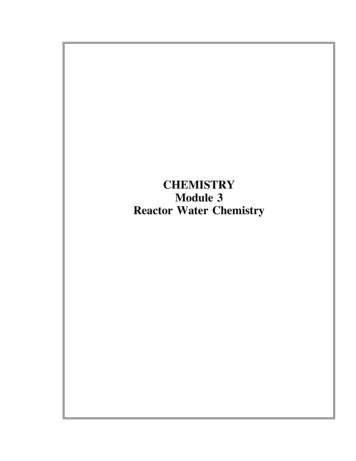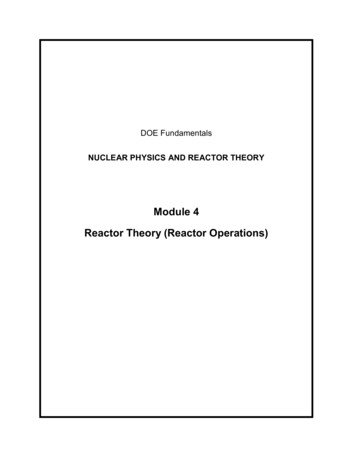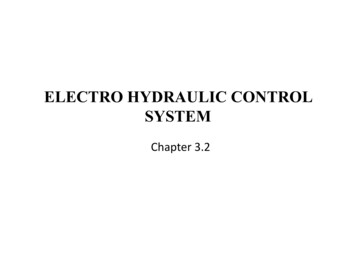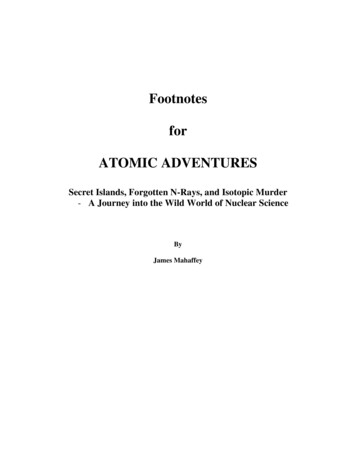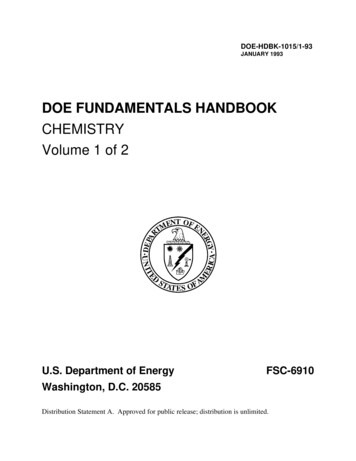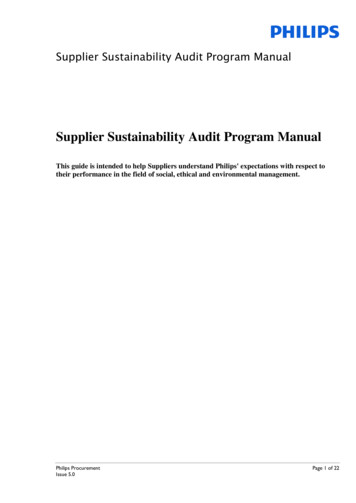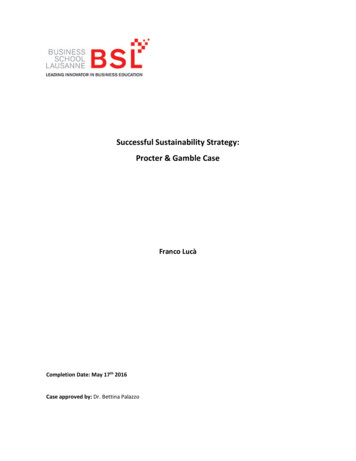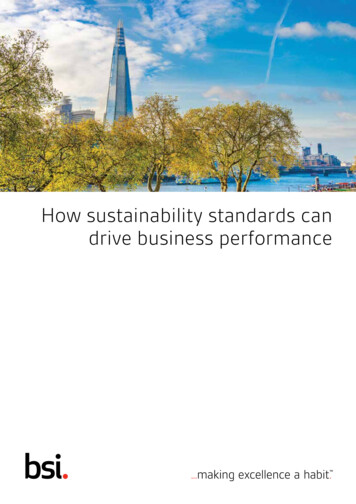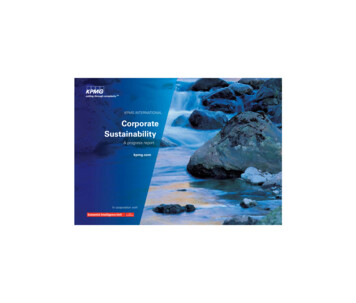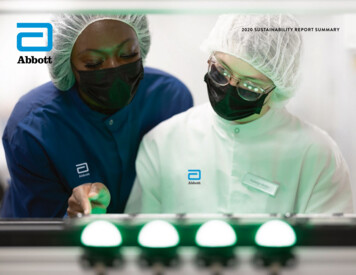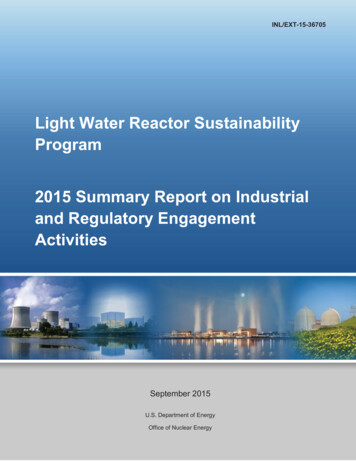
Transcription
INL/EXT-15-36705Light Water Reactor SustainabilityProgram2015 Summary Report on Industrialand Regulatory EngagementActivitiesSeptember 2015U.S. Department of EnergyOffice of Nuclear Energy
DISCLAIMERThis information was prepared as an account of work sponsored by anagency of the U.S. Government. Neither the U.S. Government nor anyagency thereof, nor any of their employees, makes any warranty, expressedor implied, or assumes any legal liability or responsibility for the accuracy,completeness, or usefulness, of any information, apparatus, product, orprocess disclosed, or represents that its use would not infringe privatelyowned rights. References herein to any specific commercial product,process, or service by trade name, trade mark, manufacturer, or otherwise,does not necessarily constitute or imply its endorsement, recommendation,or favoring by the U.S. Government or any agency thereof. The views andopinions of authors expressed herein do not necessarily state or reflectthose of the U.S. Government or any agency thereof.
INL/EXT-15-367052015 Summary Report on Industrial and RegulatoryEngagement ActivitiesKen ThomasSeptember 2015Prepared for theU.S. Department of EnergyOffice of Nuclear Energy
iii
Executive SummaryThe Advanced Instrumentation, Information, and Control (II&C) Systems Technologiespathway of the Light Water Reactor Sustainability(LWRS) Program conducts a vigorousengagement strategy with the U.S. nuclear power industry, including the nuclear operatingcompanies, major support organizations, the Nuclear Regulatory Commission (NRC), andsuppliers. The goal of this engagement strategy is to develop a shared vision and commonunderstanding across the nuclear industry of the need for II&C modernization, the performanceimprovement that can be obtained, and the opportunities for collaboration to enact this vision.The primary means of engaging the nuclear operating companies is through a UtilityWorking Group (UWG), composed of utility representatives that participate in formal meetingsand bi-monthly phone calls to provide input on nuclear plant needs and priorities for II&Ctechnologies. The 2015 UWG Summer Meeting was held in Idaho Falls, Idaho, August 11-13,which was a joint meeting with the EPRI’s Strategy Group on Performance Improvementthrough Advanced Technology. This annual summer meeting featured presentations anddemonstrations of the technologies that were developed by the II&C Pathway during FY 2015.In addition, there were presentations by the Electric Power Research Institute, Halden ReactorProject, the Nuclear Energy Institute, and Argonne National Laboratory.Two working groups were initiated during FY 2015 to provide a means for UWGmembers to focus on particular technologies of interest. The Outage Improvement WorkingGroup consists of eight utilities that participate in periodic conference calls and have access to ashare-point web page for acccess to project materials developed in the Advanced Outage ControlCenter pilot project. In the area of computer-based procedures and automated work packages,the II&C Pathway has worked with the Nuclear Information Technology Strategic Leadership(NITSL) to set up a monthly conference call with interested utility members to discuss variousaspects of mobile worker technologies.Twenty-two technical and project reports were delivered to the UWG during FY 2015,reflecting the work of the II&C Pathway pilot projects during the year. Distribution of thesereports is one of the primary means of transferring to the nuclear industry the knowledge andexperience gained during the development of advanced II&C technologies in support of LWRsustainability.Site visits to discuss pilot project activities and future plans were made to Arizona PublicService, Exelon, Duke Energy, Pacific Gas & Electric, SCANA, Southern Nuclear, South TexasProject, STARS Alliance, Tennessee Valley Authority, and Xcel. Discussions were also held onthe pathway goals and activities with major industry support organizations during FY 2102,including the Institute of Nuclear Power Operations (INPO), the Nuclear InformationTechnology Strategic Leadership (NITSL), the Nuclear Energy Institute (NEI), and the ElectricPower Research Institute.The Advanced II&C Pathway work was presented at seven major industry conferencesand informal discussions were held with key NRC staff at industry conferences. In addition,discussions were held with NRC senior managers on digital regulatory issues throughparticipation on the NEI Digital I&C Working Group.iv
Meetings were held with major industry suppliers and consultants, to exploreopportunities for collaboration and to provide a means of pilot project technology transfer.These companies included Altran, Westinghouse, Rolls Royce, Schneider Electric, Devonway,Curtis-Wright Scientech, and Scott Madden Management Consultants.In the international area, discussions were held with Electricite’ de France (EdF)concerning possible collaboration in the area NPP configuration control using intelligentwireless devices. In addition, collaboration was conducted with IFE Halden Reactor Project andKorea Atomic Energy Research Institute.v
Table of Contents1.Introduction . 12.Utility Working Group . 12.1 Background and Purpose . 12.2 Membership . 22.3 Long-Term II&C Systems Technologies Future Vision and Strategy . 22.4 2015 Summer Utility Working Group Meeting . 32.5 Monthly UWG Conference Calls . 32.6 AOCC Pilot Project Working Group . 32.7 Mobile Work Packages and Procedures Working Group . 42.8 Distribution of Project Deliverables to the UWG . 43.Meetings with Individual Nuclear Utilities . 53.1 Duke Energy . 53.2 Arizona Public Service. 63.3 SCANA . 83.4 Southern Nuclear. 83.5 South Texas Project . 103.6 Exelon . 103.7 Xcel Energy. 103.8 Tennessee Valley Authority (TVA) . 113.9 Pacific Gas & Electric (PG&E). 113.10 STARS Nuclear Alliance . 124.Meetings with Major Industry Support Groups . 134.1 NITSL . 134.2 EUCG . 134.3 Institute of Nuclear Power Operations . 144.4 Nuclear Energy Institute . 154.5 Electric Power Research Institute . 155.General Industry Meetings and Conferences. 165.1 2014 American Nuclear Society Winter Meeting . 165.2 9th International Topical Meeting on Nuclear Plant Information, Control, andHuman-Machine Interface Technologies (NPIC & HMIT 2015) . 165.3 2015 INPO Digital Workshop . 165.4 2015 Procedure Professional Association Workshop . 17vi
5.55.65.72015 Human Performance and Root Cause Trending (HPRCT) Conference . 172015 NITSL Workshop . 182015 Westinghouse Outage Optimization Workshop . 186.Meetings with Suppliers . 186.1 Altran . 186.2 ScottMadden Management Consultants . 186.3 Rolls Royce . 196.4 Westinghouse . 196.5 Curtis-Wright Scientech . 206.6 Devonway . 206.7 Schneider Electric . 207.Regulatory Engagement . 217.1 Informal Discussions with NRC I&C Managers . 217.2 Other Communication Opportunities with the NRC . 218.International . 228.1 IFE Halden Reactor Project . 228.2 Electricite’ de France (EdF) . 238.3 Korea Atomic Energy Research Institute . 239.References . 24Appendix A 2015 Utility Working Group Summer Meeting Presentation Descriptions. 25vii
AcronymsAOCCAdvanced Outage Control CenterDCSdistributed control systemEdFElectricité de FranceEPRIElectric Power Research InstituteFPGAField Programmable Gate ArraysHRPHalden Reactor ProjectHSIhuman-system interfaceII&CInstrumentation, Information and ControlINPOInstitute of Nuclear Power OperationsIRTIssues Resolution TeamISAInternational Society of AutomationLWRSLight Water Reactor SustainabilityNEINuclear Energy InstituteNITSLNuclear Information Technology Strategic LeadershipNRCNuclear Regulatory CommissionNRRNuclear Reactor RegulationR&Dresearch and developmentTVATennessee Valley AuthorityUWGUtility Working Groupviii
ix
1.IntroductionThe Advanced Instrumentation, Information, and Control (II&C) Systems Technologiespathway of the Light Water Reactor Sustainability (LWRS) Program conducts a vigorousengagement strategy with the U.S. nuclear power industry, including the nuclear operatingcompanies, major support organizations, the Nuclear Regulatory Commission (NRC), andsuppliers. The goal of this engagement strategy is to develop a shared vision and commonunderstanding across the nuclear industry of the need for II&C modernization, the performanceimprovement that can be attained, and the opportunities for collaboration to enact this vision.In FY 2015, the vision, strategy, and project work was communicated to a number of keyorganizations, including the Advanced II&C Utility Working Group, the major industry supportorganizations, and a number of important industry conferences that are attended by leaders innuclear plant instrumentation and controls as well as human performance and processimprovement.This paper presents the specific engagement activities that occurred in FY 2015 topromote awareness and participation by the nuclear power industry in the activities of the II&CPathway.2.2.1Utility Working GroupBackground and PurposeThe Advanced II&C Systems Technologies Pathway sponsors a Utility Working Group(UWG) to define and host a series of pilot projects that together will enable significant plantperformance gains and minimize operating costs in support of the long-term sustainability of theLWR fleet. At this time, the UWG consists of 14 leading U.S. nuclear utilities, representing over70% of the U.S. LWR fleet. Additional membership will be pursued for the UWG with the goalof involving every U.S. nuclear operating fleet in the program.The UWG is directly involved in defining the objectives and research activities of thispathway. The research is conducted within a set of defined pilot projects that develop digitaltechnologies to address the specific II&C modernization needs within the plant II&C systemsand operational processes. Criteria have been developed for identifying, prioritizing, andselecting potential advanced II&C pilot projects performed by II&C Pathway.UWG members serve as host utilities for the pilot projects when their internalperformance improvement objectives align with the goals of a particular pilot project. The pilotproject hosts make their facilities available for the research and development (R&D) activitiesand allows other nuclear utilities to observe the technology demonstrations. Host utilitiesregularly make presentations in key industry technical meetings to describe their motivations andefforts in the pilot projects and to communicate important findings to the industry.To allow utilities to focus on specific pilot projects of interest, the UWG sponsorsworking groups in two broad areas: 1) outage improvement and 2) mobile work packages andprocedures. The purpose of the working groups is to provide a means of focused engagement for1
utilities around the technologies of their particular interests and to provide a forum for peerreview of the technologies developed within the working group areas.2.2MembershipThe nuclear utilities participating in the UWG during FY 2015 were:1.2.3.4.5.6.7.8.9.10.11.12.13.14.Arizona Public ServiceDTE EnergyDuke EnergyEntergyExelon NuclearFirst Energy Nuclear Operating CompanyLuminantNextEraPacific Gas & ElectricPublic Service Electric and GasSouthern NuclearSouth Texas ProjectTennessee Valley AuthorityXcel EnergyIn addition, the Electric Power Research Institute (EPRI) and the IFE Halden ReactorProject (HRP) were full participants in the UWG, as well as development partners in the pilotprojects.2.3Long-Term II&C Systems Technologies Future Vision and StrategyAn update to the Advanced Instrumentation, Information, and Control SystemsTechnologies Technical Program Plan for FY 2016 (INL/EXT-13-28055 Rev. 4) [1] waspublished in September of 2015. This is a comprehensive description of the II&C modernizationstrategy and the related pilot projects. The document reflects the needs and priorities asexpressed by the UWG in the August, 2015 meeting. It also provides the background on why theII&C Pathway research is needed and it discusses certain drivers for II&C automation in thenuclear power industry.The Technical Program Plan provides detailed descriptions of the 20 pilot projects thatcompose the current research scope. The performance improvement and modernization needsare presented for each of the pilot projects, along with descriptions of what technologies will beproduced. This document has been widely distributed among the UWG, industry supportorganizations, and other interested parties. It is available on the INL LWRS web site for access.The Technical Program Plan will be updated annually as refinements are made to thescope and schedule of the II&C Pathway research program based on utility priorities andavailable project funding.2
2.42015 Summer Utility Working Group MeetingThe 2015 Utility Working Group (UWG) Summer Meeting was held at INL August 1113. This was a joint meeting with the EPRI Strategy Group on Productivity Improvementthrough Technology. A series of presentations and demonstrations were conducted the II&CPathway research team in the areas of human performance and process improvement, outageimprovement, on-line monitoring, control room upgrades, digital architecture, and cybersecurity.EPRI presented their current efforts in technology development for nuclear power plants,which included human factors guidelines, online monitoring technologies, quadcopterapplications, and a general review of all current EPRI I&C projects.IFE Halden Reactor Project presented research topics of interest in the areas of integratedoperations, virtual reality, resilient procedure use for operators, and digital safety case.Argonne National Laboratory presented their work on Plant Fault Detection andDiagnosis.The Nuclear Energy Institute (NEI) provided a summary on their activities to engage theNuclear Regulatory Commission (NRC) in issues related to digital I&C implementation.Other organizations represented at the meeting included Duke Energy, Southern Nuclear,Exelon, TVA, Arizona Public Service, INPO, EI, and KAERI (Korea). The meeting alsofeatured a tour of INL’s Advanced Test Reactor and MFC facilities.At the end of the meeting, feedback and comments were solicited from the UtilityWorking Group in terms of current project priorities and potential unaddressed utility priorities.This feedback will be included in the continuing refinement of the long-term vision and strategyfor the II&C research program.For a complete description of the presentations, see Appendix A.2.5Bi-monthly UWG Conference CallsA conference call was held with the UWG on the first Tuesday of every other month inFY 2015, to communicate ongoing status of the pilot projects, to discuss project deliverables,communicate UWG and industry meeting information, and to provide information on the overallII&C Pathway. The UWG members were able to ask questions about the specific technologiesbeing developed as well as provide their own ideas on how to make them more useful to theindustry. The calls also served as a forum for UWG members to share information amongthemselves related to their own II&C needs and plans.2.6AOCC Pilot Project Working GroupThe AOCC Pilot Project Working Group was established as a means for nuclear utilities tofocus specifically on the II&C Pathway research that relates directly to improving outagemanagement and performance. The Working Group has periodic phone calls to provide statuson the pilot project development activities and products. It provides access to the technologies,reports, and other documents that are produced by the research. It also provides opportunities for3
member companies to participate in the research activities where they have matchingdevelopment objects. Finally, it also serves as a means for the utilities to share best practices inoutage management technology applications. Participating utilities at this time are ArizonaPublic Services, Duke Energy, Entergy, Exelon Nuclear, Southern Nuclear, South Texas Project,Tennessee Valley Authority, and Xcel.The AOCC Pilot Project Working Group Sharepoint Site link is https://lwrs.inl.gov/AOCC.Those interested in participation in the Working Group and use of the Sharepoint Site can usethis link to establish an ID for access to project materials, status reports, and utility bestpractices.2.7Mobile Work Packages and Procedures Working GroupIn the area of computer-based procedures and automated work packages, the II&C Pathwayhas worked with the Nuclear Information Technology Strategic Leadership (NITSL) to set up amonthly conference call with interested utility members to discuss various aspects of mobileworker technologies. Nuclear utilities that are currently participating include Arizona PublicService, Duke Energy, Pacific Gas & Electric, SCANA, and Southern Nuclear. Additionalparticipation is being solicited through the NITSL Infrastructure and Application Subcommittee.On several occasions the II&C Pathway presented various aspects of the research from theComputer-Based Procedures (CBP) and Automated Work Packages (AWP) Pilot Projects. Thegroup has sponsored web casts with current CBP and AWP suppliers to understand currenttechnology states and to identify technology gaps for future research. The Working Group willsponsor future meetings to develop an industry consensus on utility needs and requirements forfuture CBP and AWP research.2.8Distribution of Project Deliverables to the UWGResearch pathway and pilot project deliverables have been distributed to the UWG asthey have become available throughout FY 2015, as follows:1.Cyber Security Evaluation of II&C TechnologiesINL/EXT-14-336092.Implementation of Software Tools for Hybrid Control Rooms in theHuman Systems Simulation LaboratoryINL/EXT-14-337103.A Research Framework for Demonstrating Benefits of AdvancedControl Room TechnologiesINL/EXT-14-339014.A Distributed Control System Prototyping Environment to SupportControl Room ModernizationINL/EXT-14-339575.Operator Performance Metrics for Control Room Modernization: APractical Guide for Early Design EvaluationINL/EXT-14-31511Revision 16.A Simple Demonstration of Concrete Structural Health MonitoringFrameworkINL/EXT-15-347294Revision 1
7.Digital Architecture RequirementsINL/EXT-15-346968.Requirements for Control Room Computer-Based Procedures foruse in Hybrid Control RoomsINL/EXT-15-352849.Benefits of Advanced Control Room Technologies: Phase OneUpgrades to the HSSL and Performance MeasuresINL/EXT-15-3538110.Pilot Project Technology Business Case: Mobile Work PackagesINL/EXT-15-3532711.Automated Work Package Prototype: Initial Design, Development,and EvaluationINL/EXT-15-3582512.A Pilot Study Investigating the Effects of Advanced Nuclear PowerPlant Control Room Technologies: Methods and Qualitative ResultsINL/EXT-15-3643213.2015 Summary Report on Industrial and Regulatory EngagementActivitiesINL/EXT-15-3670514.Advanced Instrumentation, Information, and Control SystemsTechnologies Technical Program Plan for FY 2016INL/EXT-13-28055Revision 415.Online Monitoring of Induction MotorsINL/EXT-15-3668116.Digital Architecture – Results From a Gap AnalysisINL/EXT-15-3666217.Monitoring, Modeling, and Diagnosis of Alkali-Silica Reaction inSmall Concrete SamplesINL/EXT-15-3668318.Development of Improved Graphical Displays for an AdvancedOutage Control Center, Employing Human Factors Principles forOutage Schedule ManagementINL/EXT-15-3648919.Verification and Validation of Digitally Upgraded Control RoomsINL/EXT-15-3670420.Computer-Based Procedures for Field Workers—Result and Insights INL/EXT-15-36615from Three Usability and Interface Design Evaluations21.Flow-Assisted Corrosion in Nuclear Power PlantsINL/EXT-15-3661122.HSI Prototypes for Human Systems Simulation LaboratoryINL/EXT-15-368393.3.1Meetings with Individual Nuclear UtilitiesDuke EnergyKen Thomas met with Duke Energy Information Technology leadership on October 14th inCharlotte, North Carolina, on the goals and expected products of the Digital Architecture PilotProject. The Duke Energy Nuclear Information Technology Strategic Leadership (NITSL)representative is the current chair of the NITSL Infrastructure and Applications (I&A)Committee, the primary interface for NITSL. Discussions were held on how Duke would benefit5
from being involved in the project. Duke confirmed their desire to participate in the effort toadvise the project on utility information technology deployment status and requirements.Ken Thomas and Shawn St. Germain met with the Duke Energy Outage Managers functionalarea group on December 18th at the Duke Energy Corporate Office in Charlotte, NC. The scope,objectives, project activities, and project deliverables of the Advanced Outage Control CenterPilot Project were presented to the outage managers of the six Duke Energy nuclear stations(McGuire, Catawba, Oconee, Robinson, Harris, and Brunswick). The Duke Outage Managersexpressed interest in becoming involved in the work beginning with observations in their springoutages followed by implementation of the AOCC collaboration technology that is now deployedby the Palo Verde, Farley, and Sequoyah nuclear stations. They agreed to participate in theAOCC Working Group and to consider additional opportunities to develop or demonstratetechnologies for outage improvement.The Digital Architecture team visited Duke Energy on July 23rd to conduct a benchmark oftheir current information technology infrastructure for the Duke nuclear plants. Duke wasrepresented by corporate and plant managers and staff. Duke provided considerable informationfor the project and agreed to continue to support in future phases.As a result of the visit to Duke in October of 2014, Shawn St Germain had opportunity toparticipate in the Duke Catawba Nuclear Station Outage Performance Assessment in March as ameans of benchmarking current industry technology needs. He visited the Duke Robinson andHarris Nuclear Stations in September to benchmark their outage technology requirements and toconvey the research findings of the pilot project to-date. The Duke McGuire Nuclear Station hasrequested a future visit to explore potential participation in the pilot project.3.2Arizona Public ServiceShawn St. Germain conducted a utility visit at Palo Verde Nuclear Generating Station toobserve outage activities October 13-16. Palo Verde continues to deploy and evaluate technologysolutions for outage management. During this refueling outage, a new voice-over-IP (VoIP)communication system was used as well as new schedule monitoring software. Palo Verdecontinues to improve the use of collaboration software for OCC status displays.Shawn St. Germain facilitated a demonstration of electronic work packages at Palo Verdeincluding real time status monitoring from the Outage Control Center (OCC) during their springrefueling outage. One of Palo Verdes work packages was rendered to a tablet device anddeployed in the field to mirror the paper work package. The shop supervisor and OCC were ableto monitor job status remotely and in real time. Feedback from Palo Verde staff was extremelypositive, both from the workers in the field and from the supervisors.Shawn St. Germain visited Palo Verde during April 6-8 and April 13-16 to observe use of thepilot project technologies at selected times during their spring refueling outage, which includedthe outage issue management technology and advanced graphical displays for the outage controlcenter.Ken Thomas and Bruce Hallbert met with station management representatives at the PaloVerde Nuclear Generating Station on December 16th to present an opportunity to participate inthe upcoming Hybrid Control Room Upgrades Benefit Study. As a result, Palo Verde agreed toparticipate and will supply their control room simulator software for installation in the HSSL and6
will provide operators for control room human factors studies both at INL (HSSL) and in theiroperator training simulator (for baseline studies). Palo Verde also expressed specific interest inthe Westinghouse Computerized Procedure System (CPS) that will be used as part of the HSSLsimulator configuration. The next steps are to develop a project plan for the Palo Verdeparticipation and present that to broader set of Palo Verde station managers.Ken Thomas met with Arizona Public Service (APS) – Palo Verde Nuclear GeneratingStation managers on July 7th on a proposal to conduct a major study for control roommodernization involving substantial funding in a cost-share arrangement. APS expressed interestin exploring this opportunity and asked for a project plan to be presented in a larger meeting withtheir station management in the August-September timeframe. There was consensus on pursuingtwo to three options for an end-point vision and conducting the first phase engineering andhuman factors studies to develop a working concept for each selected option. The follow-upmeeting has been tentatively scheduled for the week of September 7th.Digital Architect
Executive Summary The Advanced Instrumentation, Information, and Control (II&C) Systems Technologies pathway of the Light Water Reactor Sustainability(LWRS) Program conducts a vigorous
